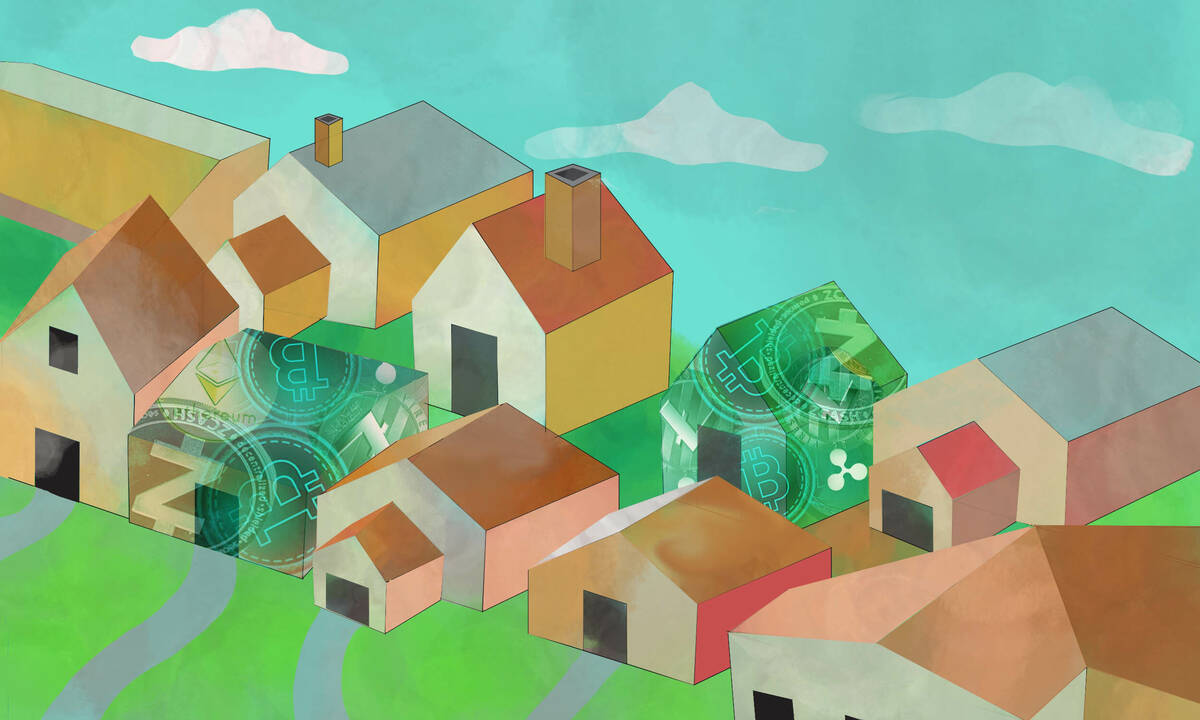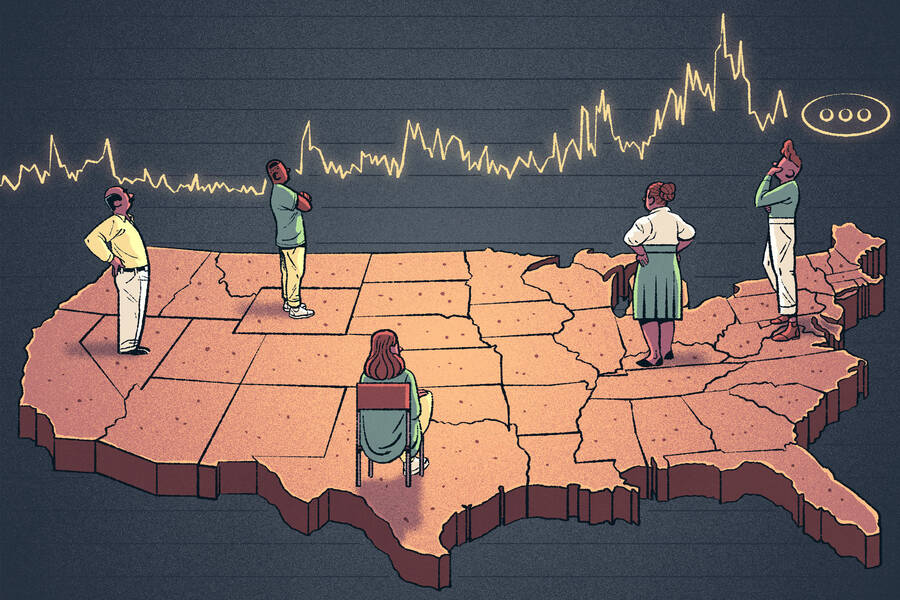Finance & Accounting Sep 1, 2023
When Crypto Went Mainstream—and Drove Up Housing Prices
Many Americans have cryptocurrency in their portfolios and treat it much like any other investment.

Yevgenia Nayberg
In late 2021, cryptocurrencies including Bitcoin and Ethereum hit their peak total market capitalization: $3 trillion. Since then, that figure has dropped closer to $1 trillion, but crypto still represents a meaningful component of investment portfolios across the United States.
Coverage of the crypto phenomenon has focused largely on whether the currency makes for a good or risky investment—that is, whether investors should board the crypto train or steer clear.
But what about the households that do purchase these currencies? How many of them are there, and what impacts do their crypto investments have on their own finances and, in turn, the broader economy?
That’s a question of interest to Scott Baker, an associate professor of finance at the Kellogg School. “Crypto is a massive new asset class with wildly fluctuating prices, but we didn’t have a good idea of who’s buying it and how that affects consumption,” he says. “Is this something people are just gambling on? What are people doing with their gains or losses?”
For example, crypto investors could be hoping to “10x” their investment, as Baker says, and then withdraw the windfall and spend it on discretionary items like second cars or vacations. Or they could be treating crypto more like a traditional investment in the stock market, holding on to the assets for longer and spending small proportions of their gains.
To better understand how crypto investing looks in practice, Baker and several collaborators—Darren Aiello, Mark Johnson, and Jason Kotter of Brigham Young, Tetyana Balyuk of Emory, and Marco Di Maggio of Harvard—studied the financial transactions of millions of U.S. households.
They discovered that over 16 percent of households have invested in cryptocurrency in the past decade. These households spent more money when their crypto investments increased in value—but not enough to suggest they treat the gains like an unexpected jackpot. “It looks more like consumption related to equity gains than to the much larger consumption response you might see for lottery winnings,” Baker says.
Still, the additional spending can have a notable impact on the broader economy, particularly in geographic regions where crypto investment is popular. In these regions, researchers were able to link crypto spending to an increase in home prices.
The “who” and “how much” of crypto
The researchers studied anonymized financial-transaction data provided by a financial aggregation and analytics firm. The dataset included detailed information for over 60 million Americans from 2010 to 2022, including their location; the money entering and departing their checking, money-market, credit-card, and other accounts; and their investments in traditional assets like stocks and newer vehicles like cryptocurrencies.
Seeing the spending flows “allows you to get this extremely granular view of household finances,” Baker says.
First, the researchers investigated who buys cryptocurrency. A lot of us, it turns out, although the 16 percent of people who have invested in crypto do tend to have somewhat higher income than people who don’t hold these assets. Most crypto investors aren’t all-in and use the assets as only one portion of their portfolios. “It’s not just a niche thing now, and it seems that people are not just using these allocations for gambling or crazy speculation,” Baker says.
“It’s not just a niche thing now, and it seems that people are not just using these allocations for gambling or crazy speculation.”
—
Scott Baker
Next, the researchers turned to how much people spend when their crypto investments increase in value. They wondered: Would households spend as though they’d accumulated gains in a more-traditional investment asset? Or would they treat the crypto gains differently, as though it was a lottery win, and spend dramatically more?
“Say you deposited $1,000 into Coinbase and that grew to $2,000 in three months due to a rise in the price of Bitcoin or Ethereum—then you have $1,000 in gains,” Baker explains. “We looked at how that predicts an increase beyond your baseline spending over the next few months.”
They found that, overall, crypto-related spending looked much more like the spending associated with traditional equity gains.
For every dollar of unrealized crypto gains, household spending increased by around 8 cents as compared with the 3 to 4 cent increase associated with unrealized equity gains and the 50 to 100 cent increase observed for lottery winners. “It’s a pretty reasonable level of spending overall,” Baker says.
But even this small increase is meaningful for the broader economy, Baker says: “Depending on how far back you go, retail crypto investors have seen hundreds of billions of dollars in gains. So spending even 5 to 6 percent of that is enough to have impact on the economy—akin to a big bull-market run-up in equities, where you see that translated into significantly increased consumer spending.”
Crypto gains mean higher home prices
So where does all that spending go?
The research uncovered the likeliest destination for crypto gains: housing. “If people withdraw larger amounts, a huge chunk of that goes toward housing,” Baker says. “We see increased mortgage spending and increases in transitions to first-time homeownership—from not paying a mortgage to paying one.” Large crypto withdrawals over $5,000, the researchers found, predicted increased mortgage payments and the purchase of a new home.
The relationship between crypto gains and housing spending was so striking that Baker and his coauthors wanted to see if it might have an impact on local-real-estate markets.
To test the theory, they went back to 2017, the first Bitcoin boom, “when crypto really jumped onto the mainstream radar,” as Baker says. “A lot of people became first-time users in that run-up and a lot of longer-term users made a boatload of gains.” The researchers then compared pre- and post-2017 housing prices in counties where lots of people held Bitcoin with prices in counties where few people did.
While housing prices trended similarly in both groups of counties before the crypto spike, they diverged post-spike, with prices increasing after 2017 in regions where lots of people held Bitcoin.
To reinforce that finding, the researchers also compared crypto holdings with housing prices at the county level. They found that, for every $1 in crypto gains per capita in a county, the median home price in that county increases by 21 cents over the next six months. Baker says it’s possible this figure is an overestimate “because we can’t observe gains outside the crypto exchanges, like from mining Bitcoin yourself or buying them from outside the exchanges. So it might be more like a 21-cent increase in house prices for $3–4 in crypto gains per capita. But it’s still a meaningful impact.”
Overall, Baker sees crypto investing as something that’s here to stay, with ongoing effects on households and the economy: “It’s a big enough asset class that it’s going to affect aggregate levels of consumer consumption, housing prices, and equity-market prices as people shift between asset classes and rebalance their portfolios. It’s going to be a larger piece of the household asset mix going forward and likely part of responsible asset allocation, as well.”
Sachin Waikar is a freelance writer based in Evanston, Illinois.
Aiello, Darren, Scott R. Baker, Tetyana Balyuk, Marco Di Maggio, Mark J. Johnson, and Jason D. Kotter. 2023. “The Effects of Cryptocurrency Wealth on Household Consumption and Investment.” Working paper.



